Pearl Jephcott produced a series of influential studies of the lives of young people and was an important figure in the development of thinking about youth club work. She also undertook a number of community studies that added significantly to our appreciation of working-class life.
contents: introduction · life · Pearl Jephcott, youth work and young people · working-class community · conclusion · further reading and references · links · how to cite this article
Photograph: Peek Freans former factory, Bermondsey where Pearl Jephcott researched Married Women Working. Photo sarflondondunc | flickr ccbyncnd2
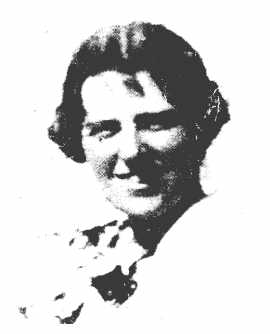
Pearl Jephcott (1900-1980) was a gifted social researcher, worker and organizer. For nearly twenty years she helped to develop and sustain girls’ and mixed clubs – and displayed a marked ability to make significant relationships with young people and those who worked with them. Alongside this work, Jephcott also began researching and writing about the lives and experiences of young women. Unlike many other researchers, she emphasized exploring the experiences and circumstances of ‘ordinary’ young people. Her research broadened out to studies of particular neighbourhoods and social phenomena. There was, again, an emphasis on the lives of ‘ordinary’ people and the environments they find themselves in (particularly their housing conditions and the impact these have) – and the actions that local people can take. In this piece, we examine her contribution and significance.
Life
Jephcottt was born on May 1, 1900, in Alcester, Warwickshire (she was named Agnes Pearl). Her mother – Agnes Amelia Boobbyer – was brought up in Breconshire in Wales and had worked as a governess for the Rector of Birtsmorton in the Malvern Hills (1881 Census). She had married Edward Arthur Jephcott in 1889 (the brother of one of her friends). He was an auctioneer and was, for a time also, the High Bailiff of Alcester. The latter meant Agnes Pearl was called upon to undertake civic duties, such as presenting bouquets to visiting dignitaries, from an early age (The Coventry Herald and Free Press – May 15, 1903). She was the youngest of four children (she had three brothers – Arthur, Robert and Archibald). By 1911 the family was living at Icknield House (Coughton, Alcester) and had a live-in domestic servant (1911 Census). Pearl’s mother continued to live there up to her death in 1952 (Tewkesbury Register, December 27, 1952).
Agnes Pearl went to Alcester Grammar School. It had begun as a chantry school in about 1490 and then became an endowed grammar school around 1592 (Johnson 1977: 6). Absorbed by Warwickshire County Council as a co-educational maintained grammar school in 1912, it moved into new buildings (op. cit.). She would have been one of the first girls to enter the school. The focus, unsurprisingly, was on preparing students to enter ‘commercial life or the Universities’, although ‘rural bias’ was given to the significant number of boys who were the children of farmers. Whilst at the Grammar school, her brother Arthur was killed in action at Pozières, Picardie, France. He was a Private with the Australian Infantry Brigade.
From Alcester Grammar School, Pearl Jephcott went on to the University of Wales, Aberystwyth (I am not sure at what point she used Pearl rather than Agnes – the 1921 Census lists her as Agnes). She graduated in 1921 with a BA (Class 2) in history (Welsh Gazette, July 14, 1921 and Turnball 2004). Interestingly, as Jephcott was leaving the history department, Josephine Macalister Brew – with whom she was to work a few years later – was to about join.
Pearl Jephcott briefly took up teaching but then moved on to secretarial training. From there she went to work in the Midlands in appeals work for Dr Barnardo’s homes (Stovin 1946). It seems likely that, alongside this work, she became involved in local girls’ clubs. In 1927 Jephcott joined the Birmingham Union of Girls’ Clubs as the organizing secretary. As Tony Jeffs (2018) has pointed out, at this point the dominant providers of groups for girls and young women were either uniformed organizations or Christian bodies such as the YWCA of Girls’ Friendly Society (GFS). Girls’ clubs had rather different roots in the women’s suffrage and labour movements and, significantly, in the Women’s Industrial Council. The latter was undertaking research into the experiences and conditions of working women. In addition, girls’ clubs often looked to religious groups (Jewish, Roman Catholic and Quaker) not welcomed by the YWCA or GFS.
According to Jean Stovin (1946), Pearl Jephcott’s work included starting one of the first Union camp houses (in Ullenhall) and finding and ‘placing’ a large number of helpers and teachers for the growing number of affiliated clubs. She was also able to widen the range and scale of activities on offer and, drawing presumably on her experience with Dr Barnardos, transformed the financial position of the Union. Alongside this, she appears to have undertaken research into the earnings and working hours of young women in Birmingham and contributed to the research undertaken by Madeline Rooff (1935) into girls’ organizations. One of the most important of Jephcott’s findings identified the demand from young women for mixed provision (Jeffs 2018).
In 1935 Pearl Jephcott transferred to County Durham as the General Organizer with the reputation of being highly effective. She wanted to develop youth work in one of the ‘special areas’ where there was high unemployment. Not only was the rate of unemployment vastly higher than in Birmingham, but the attitudes of employers to their workers and local communities were also appalling – especially in the mining areas (Jeffs 2018). Local councils were struggling to support local youth organizations, and miners’ welfare organizations tended not to support girls’ work. Soon after Jephcott arrived, she submitted a report to the National Council of Girls’ Clubs (NCGC):
The main difficulties with which we have to contend are dirt, continual dirts, bad presmises and illness. Many of the girls look and seem undernourished and are constantly having minor illnesses. When you visit an absent member you constantly find one of the family ill in bed in the living room of the house (quoted by Jeffs 2018).
As Stovin again comments, in seven years Pearl Jephcott built up from two existing unions a County Association of some 80 clubs. During this time she continued to work as a youth leader (setting up and running a small village club for several years). Direct engagement with the lives of young women – their experiences of work, home and leisure – was the ‘keynote of her work’ (op. cit.). Later on, she also undertook research into the social and cultural life of young women living in local pit villages (Goodwin and O’Connor 2013). This research, alongside material from surveys sent out by NCGC, and her youth work, helped to form the basis for her book Girls Growing Up (1942). In 1941 she was given six months’ leave of absence to complete the book (Jeffs 2018). The International Women’s News (January 7, 1944) described the book as ‘ one of the few really outstanding books produced during the present war’.
Pearl Jephcott then joined the staff of the National Association of Girls’ Clubs (formerly NCGC) as a temporary National Organizer doing research and taking an interest in Service Cadets. She applied to be the education officer for the Association but lost out to Josephine Macalister Brew. In 1943 she became Publications Secretary and the editor of Club News. Jephcott was a member of a remarkable team of women working for the Association during the war. These included, in addition to Josephine Macalister Brew – Eileen Younghusband, Madeline Rooff and Leslie Sewell. In the first year or so at the Association Girls Growing Up was published (1942), and she wrote Clubs for Girls which set out ‘briefly and simply the underlying purposes of young people’s clubs’ (Jephcott 1943: 6). She was at this time living in Holy Mount, Hampstead – and her work was celebrated in the local paper (with the wonderful title: The Hampstead and St John’s Wood News and Golders Green Gazette – January 20, 1944). The title of the news item was ‘What is wrong with our youth clubs? Challenging book by Hampstead woman’.
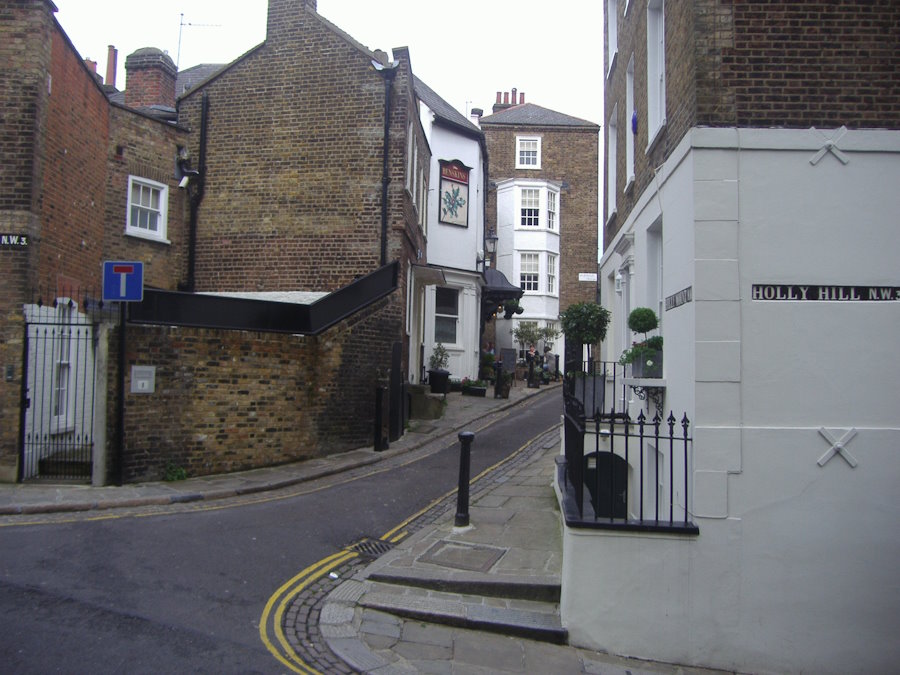
Pearl Jephcott gained a Barnett fellowship to follow up with girls in her study – and this resulted in Rising Twenty (Jephcott 1948b). In 1946 Jephcott was awarded an MA by publication – based on the three books. The same year she left what had now become the National Association of Girls’ Clubs and Mixed Clubs, to work for Political and Economic Planning (PEP). There she co-authored three of its broadsheets (Turnbull 2004) including. As part of her research, she worked incognito in a light engineering works in London reporting on the ‘virtually non-existent interest of her fellow employees in current affairs’ and arguing for more stimulating working environments (Kynaston 2007: 324; Jephcott 1948b). In 1950 she joined the staff of Nottingham University where she worked on two projects – one funded by Rockefeller exploring the social origins of delinquency (Sprott, Carter and Jephcott 1954), the other the membership of youth organizations (see Turnbull 2004). The latter project was sponsored by King George’s Jubilee Trust and resulted in Some Young People (Jephcott 1954).
From Nottingham, Pearl Jephcott became a senior research assistant at the London School of Economics (LSE) – working in the social administration department headed by Richard Titmus. Her first research project (working with Nancy Sear and John Smith) was a study of married working women. The project was based in Bermondsey (where she lived from 1956 to 1964). It focused on Peek Frean’s biscuit factory but did not have an easy passage (in part because Titmus was something of an elusive supervisor). However, the resulting book Married Women Working (1962) was a significant and reasoned contribution to the then-popular debates around the role of working wives and mothers. The work placed Jephcott within a select group of social researchers who ‘helped to reshape popular understandings of married women’s work, which they presented as a permanent feature of ‘modern’ societies rooted in irreversible demographic and socio-economic trends’ (McCarthy 2016: 269).
Whilst at the LSE she also contributed to two landmark government reports. The first, 15-18 (CACE 1959), arose out of her membership of the Central Advisory Council for Education (England). The second was The Youth Service in England and Wales (Ministry of Education 1960) the report of the ‘Albemarle Committee’ (1958-1960) where she also represented the interests of NAYLO (the National Association of Youth Leaders and Organizers). This Report effectively set out the framework for an expanded youth service. Pearl Jephcott also sought to follow up with the young women she studied in Girls Growing Up and Rising Twenty – but although the research (known as ‘The Uncertain Years’) was completed, it was never published (Turnbull 2004).
Pearl Jephcott then left the London School of Economics and began work on the North Kensington Family Study in 1962 (Eileen Younghusband was also involved). The resulting book, A Troubled Area. Notes on Notting Hill (Jephcott 1964), explored housing conditions (especially the problem of multi-occupation dwellings), the experiences of migrants, and the role of self-help and co-operative action on specific local problems. She then moved to Glasgow University to study the leisure of young people in Scotland – which resulted in Time of One’s Own (Jephcott 1967). A second project followed quickly (funded by the Joseph Rowntree Memorial Trust) – exploring the experience of high rise living. Based on nearly 1000 interviews of residents in Glasgow tower blocks, Homes in High Flats (Jephcott 1971) was the first major British contribution to debates around high-rise living and highlighted some of the common issues people experienced.
In 1970 Pearl Jephcott left Glasgow. She travelled – including spending time in Puerto Rico – but continued to research and write (including undertaking a study for UNICEF on children and young people in Hong Kong) (see Batchelor 2018). In 1973 she gained funding for a half-time post to research the needs of families in high-rise flats in Birmingham. Later, Pearl Jephcott moved to Distons Lane in Chipping Norton. In 1980 she suffered a stroke and died some months later at the nearby War Memorial Hospital (9 November) (Turnbull 2004). She was never married.
Pearl Jephcott and youth work
As we have already seen, Jephcott had substantial experience of working with young people – and supporting workers. At the request of the National Association of Girls’ Clubs, she wrote Clubs for Girls (Jephcott 1942) to help the many people who were becoming involved in the expansion of girls’ work after the start of the Second World War. The book was firmly aimed at those new to, or thinking of joining in the work. It was welcomed at the time as a succinct and accessible introduction and still repays reading as Annmarie Turnball (2002) has argued. The opening chapters looked at girls’ needs and, girls and older people. A third and central chapter examined ‘The good club’. Pearl Jephcott highlighted seven areas arising from her conversations with young women and her own experiences:
- Appearance – the quality of the physical environment.
- A breadth of membership sharing in common activities.
- A ‘good show’ i.e. plenty of different things to do.
- ‘Learning things’- exploring new areas and acquiring a wide range of interests.
- ‘Being useful’ – a club gives opportunities to do things that matter for others.
- ‘Friendliness’ – girls invariably stress one thing when they talked about what they valued in a club, Jephcott (1942: 45) concluded, ‘and that is some variation of the term friendliness’.
- ‘Someone you can talk to’. Club helpers need to be approachable, to join in, and to listen and talk with young people.
The final two chapters of the book look at the girls’ future and buildings and people. It ends by urging helpers to continually ‘encourage the members to look outside themselves and to take a friendly and generous, never hostile, interest in people and things’ (Jephcott 1942: 68). As Annmarie Turnbull (2002: 73) comments, her book models that ideal.
Clubs for Girls was well received. Elizabeth Bowen, writing in The Tatler (February 16, 1944) described it as ‘a valuable, to-the-point book of notes for new helpers, or would-be helpers, at girls’ clubs’. She continued:
It should also be read, I feel, by those who, without any immediate hope of helping, realise the importance of the work, and would like to give it sympathy and support. Absence of uplift, good-humoured realism and up-to-date grasp of facts distinguish everything that Miss Jephcott writes. And these three qualities are, again, obviously essential to the club helper.
It was significant that the review was in The Tatler – which had ‘an illustrated journal of society and the drama’ as its strapline. With worries about the impact of war on young people, books like this were discussed by newspapers and national magazines. However, the shift of focus from single-sex to mixed work meant that the book ‘was eclipsed both in terms of sales and impact by her colleague Josephine Macalister Brew’s book In the Service of Youth’ (Jeffs 2018).
Pearl Jephcott and researching the lives of girls and young people
Taken as a whole, Pearl Jephcott’s contribution to our appreciation of the lives of young people both during the Second World War and after is significant and engaging. As Annmarie Turnbull (2004) has commented about Girls Growing Up and Rising Twenty, they indicate the concerns and the style of much of Pearl Jephcott’s subsequent research:
All presented vivid, detailed, and at times passionate pictures of little researched aspects of the lives of working-class people, particularly of girls and young women. They involved ethnographical research involving participant observation, interviews, and autobiographical accounts, and offered practical recommendations to improve the quality of life of their subjects (Turnbull 2004).
How these books were brought together and written did, indeed, extend their appeal considerably. They could be read and enjoyed by a wide cross-section of people – and the approach she took to the research process still repays attention (Goodwin and O’Connor 2019).
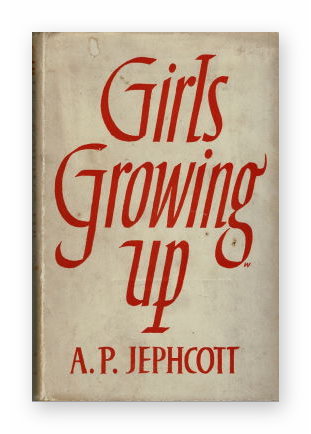
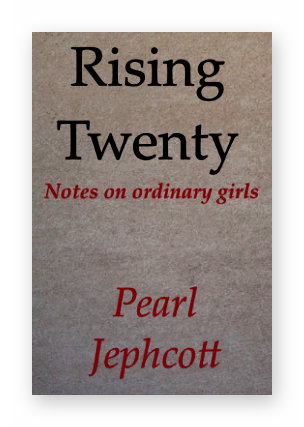
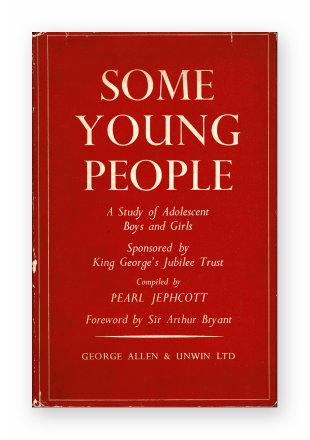
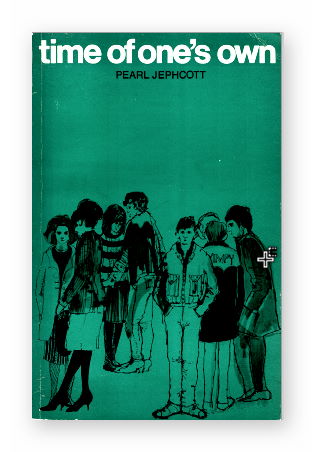
Girls Growing Up was very well received with reviews appearing in quite some local as well as national papers and magazines. Dorothy Critchlow writing in the Manchester Evening News, for example, concludes that it gave ‘a clear and conscience-searing picture of the lives of these girls (August 4, 1942). She, and several other reviewers, highlighted what Pearl Jephcott had to say in her conclusion:
About four hundred and eighty thousand boys and girls in England and Wales leave elementary schools for work each year, most of them at about the time of their fourteenth birthday. They are half children, some still reading their Beano and their comics, looking forward to the great chance of getting work, intensely interested in themselves, eager to explore anything new and ready to give their affection and their gifts to the world. It is immensely important for the community that all this vitality and potential power should be nursed into the direction in which it will make the best growth, because young people … will be the material that the world will need more than anything else during the next twenty years. They must be a generation of young people who have a burning conviction that a co-operative world is a common-sense proposition and they must have justifiable confidence in their own ability to help create it. For this they must be convinced that society is able to control what it has made. They must also be people who draw on deeper sources of satisfaction than those which material possessions can provide, but who, at the same time, are determined that when gay clothes, electric dryers, tennis courts and hiking holidays are again available, they shall be shared equally among those who need them… They must be young people who have made up their minds that all children should have as fair a chance as it is humanly possible to give them. Such things they must regard, not as vague ideals that may be achieved in some remote geological time, but as measures into which they intend to put all their abilities here and now. (Jephcott 1942: 168-9)
Jephcott was deeply concerned by the continuing poverty experienced by many working-class families and the impact it had on health, opportunity and well-being. She worried about the working conditions they were subjected to. Crucially, she also looked to the ‘democratic principles of justice and liberty’ and the value of co-operation. ‘The community’, she argued, ‘has somehow to teach its younger members that unless society learns how to live co-operatively peoples’ lives will be consistently overshadowed by wars and insecurity, by unemployment, low wages, poor holidays, dull schools, and old, overcrowded houses (1942: 158).
In Rising Twenty (1948a) Pearl Jephcott followed up with the young women that featured in Girls Growing Up and others with from two different areas – central London and a northern industrial town (possibly Barrow according to David Kynaston (2007: 418). One of the most significant findings was the continuing power of traditional orientations to marriage and work among those she talked to. Young women, for the most part, did not see themselves continuing in work once they got married (a theme she was to return to later in Married Women Working). Somehow this, and her analysis of the spending habits of young women and their interests and concerns – for example around sex – managed to become a rather racier question in the hands of journalists at The People.
This revelation of how the teen-age girl in Britain lives and thinks has come as a shock to schoolteachers and religious leaders.
They may have secretly felt that the factory girl and the shop assistant were not particularly serious-minded these days, but then along comes Miss Pearl Jephcott to prove that they are in fact obsessed only with talk of films, their personal appearance, and boys!
So far the only people who have not had a chance to comment on her revelations – made in her new book “Rising Twenty’ (Faber 8s. 6d.) – are the teen-age girls themselves. (The People October 24, 1948)
The paper had the answer:
That is Miss Jephcott’s picture of the modern girl, and the burning question to be answered is: Can it be true? Only the modern girl can give the answer, and if she does, The People is prepared to print it.
Two weeks later, they published their conclusions based on the 832 letters they received. Under the heading ‘The modern girl lets her hair down’ the writer (Anthony Russell) splits the responses between ‘good-time girls’ and ‘good livers’.
She does: If she is a good-time girl she goes to the pictures three times a week, spends two hours a day on hair and beauty treatment and devotes all her energies to captivating her boy friends.
She does not: The Teen-Age Girl does not smoke very much. The Good-Timers get most of their cigarettes from their boy friends; The Good-Livers don’t bother. (The People November 7, 1948)
Some Young People (1954) altered the focus of her work – or, rather, highlighted a theme that had run through her research around young people. Rather than looking at their lives as a whole, its main object was to deepen understanding of the relationship of ‘ordinary boys and girls’ to youth organizations (Jephcott 1954: 15). Over 900 young people were interviewed from London, Nottingham and from some rural areas in Oxfordshire and Buckinghamshire. The research found that around one in three of those aged fourteen to seventeen belonged to youth organizations with boys far outweighing girls. It also highlighted just how complicated it is for a young person to become an ‘effective member of a formal group’ (op. cit.: 105). For the Youth Service the troubles themselves fell into three categories:
They concern a more adequate supply of societies, firstly for the adolescents of rural areas; secondly for the girls in all three areas; and thirdly for the children below adolescent age in the London area. (Jephcott 1954: 142-3)
Jephcott and her researchers also argued for greater variety and more experimentation in provision – and questioned the extent to which youth organizations sought to bring external direction into ‘the one part of the day when the youngster is not controlled by parent or teacher or employer’ (Jephcott 1954: 149). She also commented on the impact of changing ideas around the function of youth organizations:
It is, for example, difficult for a unit to have precision in its aims when it is uncertain whether it is primarily an institution where further education can be piped in, so to speak; or whether it is one whose most important business is to help its members to participate in an experiment in group relations. Is the organization a device for policing the child out of mischief or one for speeding him more quickly into the adult world? A more searching alternative that faced a good number many leaders and committees was this. Should the unit for which they are responsible be adapted to the ‘average’ normal adolescent, or ought they to think first of the under-privileged, the boy or girl who most needed help? (Jephcott 1954: 152-3)
It is a set of questions that have retained their relevance – and not just to youth organizations. The book provided another opportunity for tabloid interest – a reprise of the ‘modern girl’ narrative. This time it is the Daily Mirror under the headline ‘The wolf whistle wins’:
YOUTH club or wolf whistle? Which holds the greater lure for our teen-age girls?
Some parents may pin their hopes on the youth club, but the wolf whistle wins nearly every time
For as soon as she is old enough to understand what the words mean; the modern girl begins to think about courtship and marriage
Pearl Jephcott returned to the study of young people’s lives in the mid-sixties. By now she was based at the University of Glasgow and it was to the leisure time of young Scots that she turned along with a large team of voluntary interviewers and field workers. The result was Time of one’s own (Jephcott 1967).
This research was based on a recognition that young people have ‘experienced in an exaggerated form certain of the changes which have taken place in society as a whole since the turn of the century’ (Jephcott 1967:17). With a considerable increase in the 15-19 population and the ‘opportunities and problems posed by adolescents and their free time’ (op. cit.) there was an obligation to help prepare them. The report brought out several elements that were to assume great importance over the coming decades. These included:
- The continuing – and growing – significance of the home as a setting for leisure time activity. [See Jephcott 1967: 105- 110]
- The need to develop facilities and resources for what Jephcott called ‘Leisure I’ activities. These are activities ‘pursued away from home, could often be undertaken with just a few companions or even alone, need not be planned ahead, did not involve membership of a formal group, and were relatively cheap (1967: 110). This had particular implications for the development of community schools, leisure centres and open spaces.
- The rise of ‘Leisure II’ – commercial leisure provision including cinemas, pubs and cafes.
- The changing shape of formal youth groups and what their response should be to some of the key areas of risk to young people – and the problems associated with a readiness to ‘mass label’ matters.
One further element of this research – methodology – is also worth commenting upon. The work involved 3000 young people, interviews by a large team of volunteers of around 600 of them; the keeping of personal diaries by around 1600 young people; group discussions; and a fieldwork team involving teachers and students (often involved in youth work programmes). This was quite a collective effort. In addition, and something of a novelty for the time, Pearl Jephcott used sketches produced by young people and local artists (and augmented by photographs) to generate suggestions and understanding (see Goodwin and O’Connor 2019).
Working-class community
The three major studies of working-class communities that Pearl Jephcott undertook – on the experiences of married working women in Bermondsey (1962), Notting Hill just after the riots (1964), and the experience of high-rise living in Glasgow (1971) – each made a significant contribution to their area of study. With Michael Carter, she also completed an unpublished study of ‘Radby’ (edited by W. J. H. Sprott) – that Josephine Klein drew on extensively in her Samples from English Cultures (Klein 1965). The studies were all, again, written in the trademark Jephcott style.
 Married Women Working (Jephcott with Sears and Smith 1962) throws considerable light on the experiences and situations facing such women and was published at a time when there was often ill-informed debate around the subject. However, one of the most engaging features of the book is how Pearl Jephcott was able to get inside the lives of local people in Bermondsey – the setting for her research – and to present their experiences. It certainly helped that she lived for seven to eight years in the area – and a few minutes’ walk from the biscuit factory on which her research focused (Peek Freans). Many of her neighbours worked in the factory (it employed around 1750 workers at the time). Pearl Jephcott was, thus, able to mix material gained from everyday life with data gained from more formal interviews and to create, for example, an insightful picture of the processes of ‘home-making’ and raising children (see McCarthy 2016, 2020).
Married Women Working (Jephcott with Sears and Smith 1962) throws considerable light on the experiences and situations facing such women and was published at a time when there was often ill-informed debate around the subject. However, one of the most engaging features of the book is how Pearl Jephcott was able to get inside the lives of local people in Bermondsey – the setting for her research – and to present their experiences. It certainly helped that she lived for seven to eight years in the area – and a few minutes’ walk from the biscuit factory on which her research focused (Peek Freans). Many of her neighbours worked in the factory (it employed around 1750 workers at the time). Pearl Jephcott was, thus, able to mix material gained from everyday life with data gained from more formal interviews and to create, for example, an insightful picture of the processes of ‘home-making’ and raising children (see McCarthy 2016, 2020).
Today, the neighbourhood where she lived is a park with a sixties council estate on one side and expensive apartments and flats on the other. Then, it was a rundown area next to next to the River Thames with warehouses and some newer blocks of flats. Known locally – and ironically – as ‘Paradise’ (after the central road – Paradise Street) it had suffered considerable damage during the Blitz. Her flat at 47 Rotherhithe Street was a couple of doors along from a public house [The Jolly Waterman] and next to a coal merchant (click to see a picture – and click again to see the area now on Streetview [the one remaining warehouse was 41 Rotherhithe Street – listed on Google as 1 Fulford Road]). While the flat looked out onto the Thames it was hardly salubrious but did have one or two unusual neighbours. Anthony Edward Jones – the photographer – lived a few doors past the pub (number 59) and Princess Margaret was a frequent visitor (Evening Standard 2002). The buildings were condemned in 1964 and pulled down. In living here, Pearl Jephcott was following in the footsteps of settlement workers such as Ada Salter and Grace Kimmins at the local Bermondsey Settlement and Alex Paterson from the Oxford and Bermondsey Club. They all sought to learn and create change through participating in local life. She did the same again with her later research – Homes in High Flats (1971).
 A Troubled Area (Jephcott 1964) explored the problems of Notting Dale following the ‘race riots’ of 1958. As Eileen Younghusband writes in her introduction:
A Troubled Area (Jephcott 1964) explored the problems of Notting Dale following the ‘race riots’ of 1958. As Eileen Younghusband writes in her introduction:
It is an account by someone with the vision to take in the significance of such all too familiar sights as overflowing dustbins, tired mothers with small children and heavy shopping baskets, and houses which are slatternly because they are cherished by no one — and which are cherished by no one because they are slatternly. (Younghusband in Jephcott 1964: 12)
Pearl Jephcott cut through a lot of contemporary prejudices about immigrants (at this point mostly from the West Indies and Pakistan). She focused on housing – particularly the problem of multi-occupied houses. She examined how migrants were not able to gain a foothold in council housing and were left to endure squalid conditions – and the impact this had upon them. One of the central chapters focuses on material gained from 20 multi-occupied houses over six months – and it is damning. Jephcott catalogues how expensive the rents were, the poor amenities, tensions around shared facilities, and how Notting Dale’s over-confined houses exposed ‘small children to so many hazards’ (Jephcott 1964: 89). In a second chapter on housing, in general, she brings out the nature and scale of exploitation by landlords. Another chapter examines the experiences of ‘residents from overseas’. Not unexpectedly, Jephcott also looked at children’s play and adolescents’ leisure. However, one of the significant themes running through the book is that the nature of the problems is well known – what is needed is action. Crucially, while recognizing the importance of action by the state, Pearl Jephcott also examines the contribution that the considerable core of residents ‘who given some lead, might co-operate with their neighbours to tackle some of the area’s more obvious problems’ (Jephcott 1964: 19). She concludes, based on the results from three local experimental projects undertaken as part of the research, that there is considerable room for developing much better opportunities for children’s play, for example, through community co-operation. She also argues that far more work is needed to enlist the active help of local people ‘at all social levels’ (op. cit.: 140).
One of the problems with the orientation to action here is that it may have been at the cost of attention to developments in thinking around ‘race’ and ethnicity in societies. Helen McCarthy (2019) has drawn attention to this and noted a lack of engagement with key contemporary researchers such as Ruth Glass (1960). The only references to the literature in this area appear towards the end of the book where Sheila Paterson (1963) is cited and, on the next page, an essay by Colin MacInnes is quoted from (Jephcott 1964: 101). Jephcott does not engage with relevant sociological literature here and it leads to a weakening of her analysis. On the other hand, her belief in reducing inequality, and in engaging people and finding practical ways of improving their lives is a great strength. The problem is one of balance. Today, too much of the literature falls the other way and focuses on academic concerns, failing miserably to speak to ‘ordinary people’ or to facilitate change.
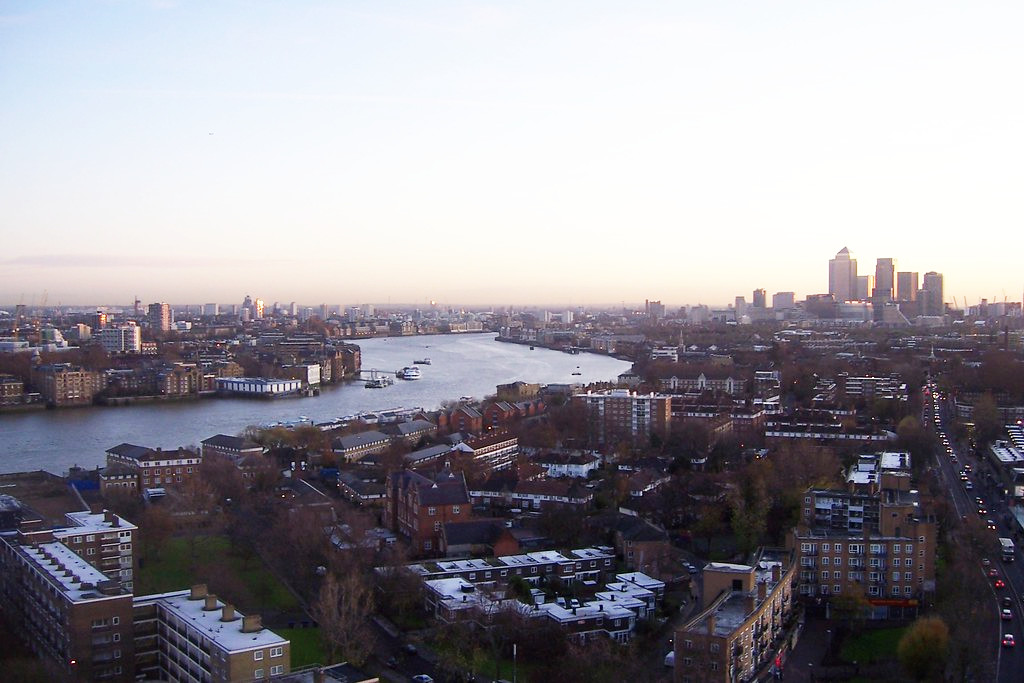
Picture of the area of Bermondsey where Pearl Jephcott lived
by sarflondondunc | flickr ccbyncnd2 licence.
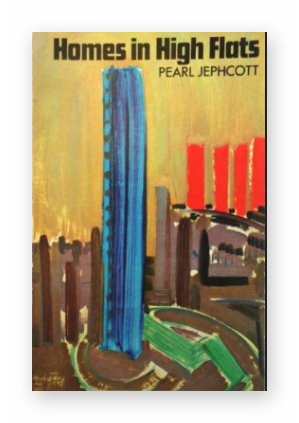 Homes in High Flats (Jephcott with Robinson 1971) was the first major study of the experience of high rise living in Britain. As such it was something of a landmark text. Significantly it both brought out the issues for residents e.g. problems around common parts and lifts, stress, and space for children’s play (issues that bear an uncanny resemblance to what Octavia Hill had identified in the 1890s), and the extent to which many residents valued living in tower blocks (e.g. the quality of the flats themselves, the views, and the locations). Some years later Alice Coleman (1985: 11-13) was to criticize this aspect of Jephcott’s research in that Glasgow – where the research mostly took place – as a special case. The previous conditions in which residents had lived were problematic when compared to the high-rise blocks. However, she also recognized the importance of the contribution that Pearl Jephcott had made – and the extent to which policymakers had cherry-picked her research to emphasize the positive side of high-rise living rather than deal with her findings around vandalism and stress (op. cit.: 181). One of the significant points about this debate is that it tends to be design rather than the height that creates many of the problems identified by Jephcott. Another is that how blocks are managed can make a major difference to residents’ experiences. The picture above of Bermondsey, for example, is taken from one of a pair of 21-storey tower blocks run by the tenants themselves (as a co-operative) rather than the council or a housing association. It resulted in a long-term focus on improving common parts and lifts and dealing with the daily issues of living close to each other. [The author of this piece was a member of the cooperative].
Homes in High Flats (Jephcott with Robinson 1971) was the first major study of the experience of high rise living in Britain. As such it was something of a landmark text. Significantly it both brought out the issues for residents e.g. problems around common parts and lifts, stress, and space for children’s play (issues that bear an uncanny resemblance to what Octavia Hill had identified in the 1890s), and the extent to which many residents valued living in tower blocks (e.g. the quality of the flats themselves, the views, and the locations). Some years later Alice Coleman (1985: 11-13) was to criticize this aspect of Jephcott’s research in that Glasgow – where the research mostly took place – as a special case. The previous conditions in which residents had lived were problematic when compared to the high-rise blocks. However, she also recognized the importance of the contribution that Pearl Jephcott had made – and the extent to which policymakers had cherry-picked her research to emphasize the positive side of high-rise living rather than deal with her findings around vandalism and stress (op. cit.: 181). One of the significant points about this debate is that it tends to be design rather than the height that creates many of the problems identified by Jephcott. Another is that how blocks are managed can make a major difference to residents’ experiences. The picture above of Bermondsey, for example, is taken from one of a pair of 21-storey tower blocks run by the tenants themselves (as a co-operative) rather than the council or a housing association. It resulted in a long-term focus on improving common parts and lifts and dealing with the daily issues of living close to each other. [The author of this piece was a member of the cooperative].
Conclusion
Pearl Jephcott’s contribution to our appreciation of young people’s lives and our understanding of youth work was significant. Importantly, she also was able to explore some key aspects of working-class communities with sensitivity and insight. As a practitioner she could form relationships, and develop and extend work; as a researcher she was able to join in with local ways of life, to listen carefully and to make sense of what she found in ways that were accessible to the reader unfamiliar with the situations she described. Reflecting on her time working with girls and clubs for young people, Jean Stovin (her successor as Durham County Organizer) commented:
In her are blended a most refreshing sense of humour, unflagging energy, tireless patience an a real sincerity of purpose; she had not time for the dabblers and titivators of social work.
… to her many friends, Pearl is known and liked as a grand companion to work and play with, and herself spreads a zest for life wherever she goes. (Stovin 1946)
Pearl Jephcott was committed to the people she found herself among, and to working with them to build better lives. The way she approached both her work as a youth organizer and as a social researcher, still repays reflection and study.
References
Batchelor, Susan A. (2018). In the footsteps of a quiet pioneer: revisiting Pearl
Jephcott’s work on youth leisure in Scotland and Hong Kong, Women’s History Review 28:5. [https://core.ac.uk/download/pdf/84148523.pdf. Retrieved August 20, 2020].
Central Advisory Council for Education (England) (1959). 15 to 18. A report of the Central Advisory Council for Education Volume 1 (The Crowther Report). England. London: HMSO.
Coleman, Alice (1985). Utopia on Trial. Vision and reality in planned housing. London: Shipman.
Evening Standard (2002). The secrets of Margaret’s London, 11 February. [https://www.standard.co.uk/news/the-secrets-of-margarets-london-6302228.html. Retrieved June 4, 2020].
Glass, Ruth Lazarus (1960). London’s Newcomers: The West Indians in London. London: Centre for Urban Studies, University College.
Goodwin, John and O’Connor, Henrietta. (2013). Ordinary Lives: ‘Typical Stories’ of Girls’ Transitions in the 1960s and the 1980s, Sociological Research Online, 18 (1) 4. [http://www.socresonline.org.uk/18/1/4.html. Retrieved May 30, 2020].
Goodwin, John and O’Connor, Henrietta (2019). Pearl Jephcott:
reflections, resurgence and replications, Women’s History Review, 28:5, 711-727. [https://www.tandfonline.com/doi/pdf/10.1080/09612025.2018.1472888?needAccess=true. Retrieved: May 29, 2020].
(2019). Pearl Jephcott: girls’ club worker, Women’s History Review, 28:5, 746-761. [https://www.tandfonline.com/doi/full/10.1080/09612025.2018.1472891?src=recsys.]
Jephcott, Agnes Pearl (1942). Girls Growing Up. London: Faber and Faber.
Jephcott, Pearl (1943). Clubs for Girls. Notes for new helpers at clubs. London: Faber and Faber.
Jephcott, Pearl (1946). Clubs, Societies and Democracy. Oxford: PEP.
Jephcott, Pearl (1948a). Rising Twenty. Notes on ordinary girls. London: Faber and Faber.
Jephcott, Pearl (1948b). article in the New Statesman, September 11.
Jephcott, Pearl (1954). Some Young People. London: George Allen and Unwin.
Jephcott, Pearl/London School of Economics (1960). Women wife and worker. Problems of progress in industry, 10. London: Her Majesty’s Stationary Office.
Jephcott, Pearl with Nancy Sear and John H. Smith (1962). Married Women Working. London: Routledge and Kegan Paul.
Jephcott, Pearl (1964). A Troubled Area. Notes on Notting Hill. London: Faber and Faber.
Jephcott, Pearl (1967). Time of One’s Own: Leisure and young people. Edinburgh: Oliver and Boyd.
Jephcott, Pearl with Robinson, Hilary (1971). Homes in High Flats. Some of the human problems involved in multi-storey housing. Edinburgh: Oliver and Boyd.
Johnson, Cyril (1997). Alcester’s Grammar School. The first five hundred years. Alcester: Alcester Grammar School. [http://www.alcester.net/AGS_first_500.pdf. Retrieved: May 29, 2020].
Kynaston, David (2007). Austerity Britain 1945-51. London: Bloomsbury.
MacInnes, Colin (1961). England, Half English. London: MacGibbon and Kee.
McCarthy, Helen (2016). Social Science and Married Women’s Employment in Post-War Britain, Past & Present 233 (1) November 2016 pp 269-305. [https://doi.org /10.1093/pastj/gtw035].
McCarthy, Helen (2019). Pearl Jephcott and the politics of gender, class and race in post-war Britain, Women’s History Review, 28:5, 779-793. [https://www.tandfonline.com/doi/full/10.1080/09612025.2018.1472896.].
McCarthy, Helen (2020). Double Lives: A History of Working Motherhood. London: Bloomsbury.
Ministry of Education (1960). The Youth Service in England and Wales (‘The Albemarle Report’), London: Her Majesty’s Stationery Office.
Paterson, Shelia (1963). Dark Strangers. A sociological study of the absorption of a recent West Indian migrant group in Brixton. London: Tavistock.
Rooff, M. (1935). Youth and Leisure. A survey of girls’ organisations in England and Wales. Edinburgh: T. and A. Constable.
Sprott, Walter J. H., Pearl Jephcott and Michael P. Carter (1954). The Social Background of Delinquency [Mimeograph]. Nottingham: University of Nottingham Department of Philosophy.
Stovin, Jean (1946). ‘Pearl Jephcott’, Club News, May p. 2.
Turnbull, Annmarie (2000). ‘Giving girls a voice: Pearl Jephcott’s work for young people’ Youth and Policy 66: 88-100.
Turnbull, Annmarie (2002) ‘Classic texts revisited: Clubs for Girls’ Youth and Policy 73: 66-74.
Turnbull, Annmarie (2004). ‘Jephcott, (Agnes) Pearl (1900-1980)’ Oxford Dictionary of National Biography, Oxford: Oxford University Press.
Useful links
pearljephcott.com: A site devoted to her work and research inspired by her.
Exploring social action: A walk in Bermondsey and Rotherhithe. Click for a guide to the walk which takes in Rotherhithe Street, the work of Pearl Jephcott and local settlements.
Acknowledgement: Thanks to Phyllis Willmott who talked to me about Pearl Jephcott’s time at the LSE and to Tony Jeffs who has researched Jephcott’s time in Birmingham and Durham.
Main image: Peek Freans former factory, Bermondsey where Pearl Jephcott researched Married Women Working. Photo sarflondondunc | flickr ccbyncnd2
To cite this article: Smith, Mark K. (2024). ‘Pearl Jephcott, youth and the lives of ordinary people’, The encyclopedia of pedagogy and informal education. [https://infed.org/mobi/pearl-jephcott-youth-and-the-lives-of-ordinary-people/. Retrieved: insert date].
© Mark K Smith 2008, 2020, 2024
